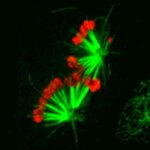Genetics & Molecular Biology

Humans have an unclear number of genes - ab initio gene finding and comparative gene finding yield different totals (see the Human Genome Project for details) - but it is likely in the low 20,000s and those genes make nearly as many proteins. The functions of most genes have not been fully determined, but knowing what a particular gene does could obviously help researchers understand disease processes and identify targets for new drugs.
A new paper says genes that have roles in the same biological pathways change their rate of evolution in parallel, a finding that could be used to…

Bt corn, which is engineered to produce the bacterial toxin, Bt, that organic farmers spray on foods all of the time, is better than a pesticide because is naturally resists attack by the corn rootworm, a pest that feeds on roots and can cause losses of up to $1 billion annually.
It also resulted in an unexpected benefit; the Bt trait has also boosted corn yields. But why?
Fred Below and Jason Haegele of the University of Illinois at Urbana-Champaign set out to answer that question by determining how Bt corn uses nitrogen in the soil. Nitrogen is an important nutrient for corn, and with…

Celiac disease is not controversial, some people have always had it. But belief that it is on the rise - some claims are that the disease is four times more common today - rather than being diagnosed better, is controversial. And there is confusion created by marketing people who want to increase awareness of their products for dietary fashion reasons.
But one claim by concerned consumers merited scientific curiosity: that if there was an increase in celiac disease it may be caused by farmers growing strains of wheat that contain more gluten.
Celiac disease occurs when gluten, a…

Bacteria resistant to antibiotics may be the subjects of sci-fi Hollywood horror, but it is also the reality at hospitals across the country. There are ongoing complaints that feeding animal antibiotics puts us all at risk to bacteria that are resistant to these antibiotics as well other antibiotics in the same family. Even the ornamental fish industry is at risk (and humans through them).
New antibiotics are few and far between, and some bacteria seem particularly adept at evolving into stronger forms of themselves, gaining genetic material to protect themselves against even…

A new study in mice found that it might be possible to fine-tune mitochondria, tweaking one aspect to increase insulin sensitivity, reduce body and fat mass, and even extend life.
The researchers say exploiting this target could one day lead to novel treatments for type 2 diabetes, an endocrine system disease that affects 8 percent of the U.S. population. The research also points to promising new avenues of investigation in the biology of aging.
The studyfound that diminished activity of a protein complex involved in mitochondrial function was associated with healthy changes in the mice. The…

In light of ethical concerns with using human embryonic stem (hES) cells for research and therapeutic development, scientists have since developed technologies to allow one to reprogram somatic cells into pluripotent stem cells that are akin to hES cells.
With the advent of induced pluripotent stem cell (iPSC) technology in 2006, scientists can now easily reprogram somatic cells into pluripotent stem cells. Although an incredible achievement, there still remains considerable skepticism with regards to whether iPSCs truly behave like ES cells, whether information garnered from iPSCs in…

Epigenetics is a nascent, exciting field and due to its broad scope, it is used to rationalize the 'it might be so' potential of the mundane (evolutionary psychology) to the silly (social psychology) but some new research reveals a potential way for how parents' experiences could be passed to their offspring's genes.
Epigenetics is a system that turns our genes on and off. The process works by chemical tags, known as epigenetic marks, attaching to DNA and telling a cell to either use or ignore a particular gene. The most common epigenetic mark is a methyl group. When these groups fasten…

Our behavior is critically linked to our genetics but the relationship remains murky. Genes, by constructing our brain and nervous system and by regulating our hormones, influence behavior — in humans and in all animals.
Ironically, the science is the least clear where the connection between genetics and behavior should be, in theory, the most direct — in cases of “hard-wired” behavior such as the construction of beehives or the courtship rituals of some bird species or a human infant’s rooting; behaviors that are common across a species without having to be taught. Instinct.
Biologist-…

Studies are revealing new details about a molecular surveillance system that helps detect and correct errors in cell division that can lead to cell death or human diseases.
The purpose of cell division is to evenly distribute the genome between two daughter cells. To achieve this, every chromosome must properly interact with a football-shaped structure called the spindle. However, interaction errors between the chromosomes and spindle during division are amazingly common, occurring in 86 to 90 percent of chromosomes, says cell biologist Thomas Maresca at the University of Massachusetts…

The IFIT protein enables the human immune system to detect viruses and prevent infection by acting as foot soldiers guarding the body against infection. They recognize foreign viral ribonucleic acid (RNA) produced by the virus and act as defender molecules by potentially latching onto the genome of the virus and preventing it from making copies of itself, blocking infection.
This discovery of this molecular blueprint was made by teams led by Bhushan Nagar, a professor in the Department of Biochemistry at McGill's Faculty of Medicine, and Dr. Giulio Superti-Furga at the Research Center…